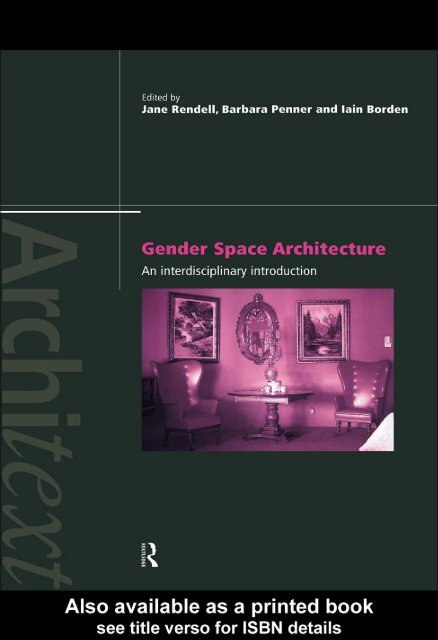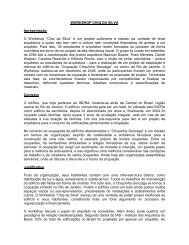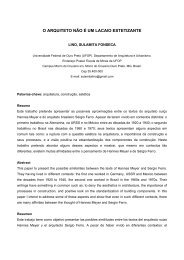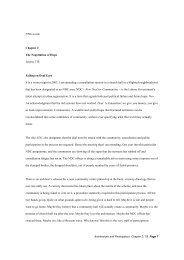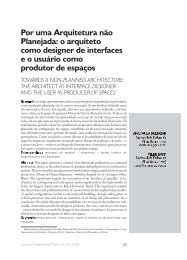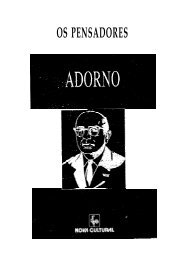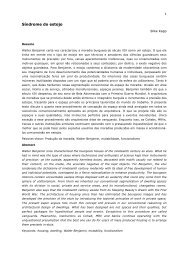Gender Space Architecture: An Interdisciplinary Introduction
Gender Space Architecture: An Interdisciplinary Introduction
Gender Space Architecture: An Interdisciplinary Introduction
- No tags were found...
Create successful ePaper yourself
Turn your PDF publications into a flip-book with our unique Google optimized e-Paper software.
<strong>Gender</strong> <strong>Space</strong> <strong>Architecture</strong>This significant text brings together for the first time the most important essaysconcerning the intersecting subjects of gender, space and architecture. Carefullystructured and supplied with introductory essays, it guides the reader throughtheoretical and multi-disciplinary texts to direct considerations of gender in relationto particular architectural sites, projects and ideas.<strong>Gender</strong> <strong>Space</strong> <strong>Architecture</strong> marks a seminal point in gender and architecture,both summarising core debates and pointing towards new directions anddiscussions for the future. It will be useful to a wide range of readers wishing toexplore this burgeoning new field, including those from architecture, art history,anthropology, cultural studies, gender studies and urban geography.Jane Rendell is Senior Lecturer in <strong>Architecture</strong> at the University of Nottingham.Barbara Penner is conducting her doctoral research into architecture and romanceat Birkbeck College, London, Iain Borden is Director of Architectural History andTheory as well as Reader in <strong>Architecture</strong> and Urban Culture at The Bartlett, UniversityCollege London.
THE ARCHITEXT SERIESEdited by Thomas A.Markus and <strong>An</strong>thony D.KingArchitectural discourse has traditionally represented buildings as art objects or technicalobjects. Yet buildings are also social objects in that they are invested with social meaningand shape social relations. Recognising these assumptions, the Architext series aims tobring together recent debates in social and cultural theory and the study and practice ofarchitecture and urban design. Critical, comparative and interdisciplinary, the books in theseries will, by theorising architecture, bring the space of the built environment centrally intothe social sciences and humanities, as well as bringing the theoretical insights of the latterinto the discourses of architecture and urban design. Particular attention will be paid toissues of gender, race, sexuality and the body, to questions of identity and place, to thecultural politics of representation and language, and to the global and postcolonial contextsin which these are addressed.Already published:Framing PlacesMediating power in built formKim DoveyForthcoming titles:Moderns AbroadItalian colonialism and constructionMia FullerThe <strong>Architecture</strong> of OppressionThe SS, forced labor and the NaziMonumental Building EconomyPaul Jaskot<strong>Architecture</strong> and LanguageThomas A.Markus and Deborah Cameron<strong>Space</strong>s of Global Cultures<strong>An</strong>thony D.KingBeyond the Postcolonial<strong>Architecture</strong>, Urban <strong>Space</strong> and Political CulturesAbidin Kusno
Edited byJane Rendell, Barbara Penner andIain Borden<strong>Gender</strong> <strong>Space</strong> <strong>Architecture</strong><strong>An</strong> interdisciplinary introductionLondon and New York
First published 2000 by Routledge11 New Fetter Lane, London EC4P 4EESimultaneously published in the USA and Canadaby Routledge29 West 35th Street, New York, NY 10001Routledge is an imprint of the Taylor & Francis GroupThis edition published in the Taylor & Francis e-Library, 2003.© 2000 Selection and editorial content, Jane Rendell, Barbara Penner and Iain Borden;individual chapters, the contributorsThe right of Jane Rendell, Barbara Penner and Iain Borden to be identified as the Authorof this Work has been asserted by them in accordance with the Copyright, Designs andPatents Act 1988.All rights reserved. No part of this book may be reprinted orreproduced or utilized in any form or by any electronic, mechanical,or other means, now known or hereafter invented, including photocopyingand recording, or in any information storage or retrieval system, withoutpermission in writing from the publishers.British Library Cataloguing in Publication DataA catalogue record for this book is available from the British LibraryLibrary of Congress Cataloging in Publication Data<strong>Gender</strong> space architecture: an interdisciplinary introduction/editedby Jane Rendell, Barbara Penner, Iain Borden.p. cm.—(Architext series)Includes bibliographical references and index.ISBN 0-415-17252-7 (hb).—ISBN 0-415-17253-5 (pbk.)1. <strong>Architecture</strong> and women. 2. <strong>Space</strong> (<strong>Architecture</strong>)3. <strong>Gender</strong> (Feminism) I. Rendell, Jane, 1967– . II. Penner, Barbara, 1970– .III. Borden, Iain, 1962– IV. Series.NA2543.W65G46 1999 99–12322720´.82–dc21CIPISBN 0-203-44912-6 Master e-book ISBNISBN 0-203-75736-X (Adobe eReader Format)ISBN 0-415-17252-7 (hbk)ISBN 0-415-17253-5 (pbk)
37 Henry Urbach‘Closets, Clothes, disclosure’*from Duncan McCorquodale, Katerina Rüedi and Sarah Wigglesworth (eds),Desiring Practices: <strong>Architecture</strong>, <strong>Gender</strong> and the <strong>Interdisciplinary</strong> (1996)The word ‘closet’ holds two distinct but related meanings. On the one hand, acloset is a space where things are stored. In this regard we might say, ‘Your clothesare in the closet.’ But when we observe, ‘Joe has been in the closet for years,’ weare not recounting his efforts to match trousers and tie. Instead, we are describinghow he makes himself known to others. In this sense, the closet refers to a waythat identity, and particularly gay identity, is concealed and disclosed. Concealedand disclosed because gay identity is not quite hidden by the closet, but not quitedisplayed either. Rather, it is represented through coded gestures that sustainuncertainty.These two closets are not as different as they might appear. Taken together,they present a related way of defining and ascribing meaning to space. They bothdescribe sites of storage that are separated from, and connected to, other roomlikespaces, spaces of display. Each space—storage and display—excludes anddefines, but also depends upon the other. The non-room, the closet, housesthings that threaten to soil the room. Likewise, in a social order that ascribesnormalcy to heterosexuality, the closet helps heterosexuality to present itself withcertainty. The stability of these arrangements—a clean bedroom free of junk, anda normative heterosexuality free of homosexuality—depends on the architecturalrelation between closet and room.The two closets resonate against one another within a linguistic and materialnetwork of representations that organise the relation between storage and display,secrecy and disclosure. The sexual closet refers, through an operation of metaphor,to the familiar architectural referent. The built-in closet, in turn, petrifies anddisseminates, as architectural convention, the kind of subjectivity described by thehomosexual closet. The built-in closet concretises the closet of identity, while thecloset of identity literalises its architectural counterpart.Despite their overlapping meanings in the present, the two closets bearhistories that remain distinct and irreducible. We will take each of these in turn,beginning with the built-in closet, and focusing in particular on the clothes closet,342
(37) ‘Closets, Clothes, disClosure’ Figure 37.1Second-floor plan for a labourer’scottage showing closet hiddenwithin the wall cavityeven though closets have also been used for storing liners, cleaning supplies andother provisions. The closet we know today was invented as a new spatial type inmid-nineteenth-century America. For centuries, Europeans and Americans hadstored clothing in furniture; sometimes it hung from wall pegs or hooks. Now, forthe first time, a kind of wall cavity was produced for household storage. Brisklydisseminated among all social classes, the closet effectively outmoded wardrobe,armoire and chest. These free-standing, mobile cabinets (which still exist, butwithout the same primacy) had encased clothing within the precinct of the room.Now, the place of storage was at, or more precisely beyond, the room’s edge.Armoires, chests and the like are volumetric objects with unambiguous spatialpresence. By contrast, the closet presents itself more surreptitiously. Where theformer are decorative objects, often lavished with paint, carving and inlay, the closetexpresses itself only by a door plane, often smooth and unadorned. Unlike thecloset, storage cabinets often display locks or key holes to indicate their concealedinterior at the exterior surface. Free-standing, decorated, upright objects, armoiresand the like are able to suggest, if not quite imitate, the clothed human body.From about 1840 onwards, the closet offered, instead, diminishedarchitectural expression. The storage of clothing had been respatialised as a kindof shameful secret. The closet not only concealed the things it contained but,significantly, it also promised to hide itself.One of the most influential of the mid-nineteenth-century American ‘patternbooks’, <strong>An</strong>drew Jackson Downing’s Cottage Residences, first published in 1842,describes the closet in the following, perfunctory way:The universally acknowledged utility of closets renders it unnecessary for us to sayanything to direct attention to them under this head. In the principal story, a pantryor closets are a necessary accompaniment to the dining room or living room, butare scarcely required in connection with any of the other apartments. Bed-roomsalways require at least one closet to each, and more will be found convenient. 1As spaces which merely accompany fully described rooms, closets are outlined inplan drawings but not otherwise elaborated. This is likewise the case with anotherpattern book of the period, Samuel Sloan’s The Model Architect of 1852. Although343
Henry Urbach Figure 37.2 Free-standing mobilecabinetsFrom The <strong>Architecture</strong> of CountryHousesSloan lavishes attention on a myriad aspects of house planning and construction,he mentions closets only in passing to say that they must be ‘fitted up and fullyshelved’. 2 Their height, ventilation, light, surface treatment and other spatialqualities are not represented at all. In these mid-nineteenth-century texts, as inconstructed domestic space, the closet was rendered barely visible.Concealing the storage of clothes and other possessions, the closet mayhave served to address widespread ambivalence about material acquisition andthe accumulation of excess. This ambivalence appears clearly in an 1882 lectureby Harriet Beecher:The good sense of the great majority of business men—and women—is in favourof enterprise, and of that frugality and economy which shall result in amassingproperty…. <strong>An</strong>d yet there exists at the same time in the community…a vague senseof the unspirituality of the treasures of this life, and of the dangers that inhere inthem, together with some sort of conscience—they know not what—or fear. 3For Americans of the period, encountering an expanding industrial economyalongside the resurgence of Christian morality, wealth had come to representboth virtue and decadence. It could be amassed but not comfortably shown. In344
(37) ‘Closets, Clothes, disClosure’ this context, it seems, Americans looked to the closet to moderate display whilenot interfering with actual possession.The closet worked, along with other architectural strategies, to advance anextensive reform movement that aimed to invest the American home with signs ofmoral propriety. Increasingly strict codes of behaviour were given architectural formas, for instance, the stairway to second-floor bedrooms moved out of the entrancehall to a less visible part of the interior. Likewise, programmes and spaces oncejoined were separated into discrete rooms with distinct degrees of privacy. At a widerange of architectural scales, efforts mounted to moderate the visibility of spacesnow deemed private. Downing proposed that the ‘ideal’ of domestic planning wasto keep ‘each department of the house…complete in itself, and intruding itself butlittle on the attention of the family or guests when not required to be visible.’ 4Consistent with other transformations of the American house, in a relatively smallbut powerful way, the closet provided concealment without eliminating access.Holding clothes in abeyance, the closet not only hid ‘excess’ in generalterms, but more specifically the sartorial multiplicity of the wardrobe. If a person’svarious garments offer a repertory for self-representation, the closet served toensure, instead, that only those garments worn at any particular moment wouldbe visible. In this way, what was worn could sustain a kind of singular legitimacy.The closet contained the overflow of garments and their meanings to heedDowning’s maxim, a statement which neatly captures the spatial thrust of the era:The great secret of safe and comfortable living lies in keeping yourself andeverything about you in the right place.’ 5In the course of the last century and a half, the architecture of the closet hassustained a particularly strict relation between closet and room. Regardless of adjacentconditions, the closet usually opens to a single room—a room it is said to be ‘in’—even though, in fact, it is next to this room, or between one room and another. Ingeneral, closets receive neither anterior nor lateral expression. Windows or doorsrarely appear at the rear or side of the closet, even though they might serve to admitlight and air as well as passage. 6 A monogamous relation thus emerges betweenthe closet and its room, between the room and its closet. The room relies exclusivelyon its closet and the closet depends uniquely upon its room.The threshold between closet and room mediates their relation,simultaneously connecting and dissociating the two spaces. Although the closetdoor may take many forms (among them, sliding, pocket and hinged single ordouble doors), the door always shuts to conceal the interior of the closet andopens to allow access. Moreover the door is usually articulated to minimise itsown visibility, often set flush or painted to match the surrounding wall. As muchas possible, the closet presents itself as an absence, a part of the (not-so) solid wallat the room’s edge. According to a domestic planning manual from the 1940s:‘Closets should not interfere with main areas of activity in a house. They shouldbe accessible but inconspicuous’. 7The tension between visual concealment and physical access has driven thearchitectural elaboration of the closet/room pair. But, despite its formidable345
Henry Urbach architectural strength, it fails to contain the tension exerted by contrary imperatives:storage versus display, keeping things hidden versus keeping things handy. Thecloset, in the end, can only be so inconspicuous. The door cannot help but hintat the space beyond its planar surface. There is always some seam, gap, hinge,knob or pull that reveals the door as a mobile element. Moreover, the door displaysthe presence of the closet beyond by setting parameters for decorating andfurnishing the room. One does not, for example, place furniture in front of acloset door as though it were part of the wall.Holding things at the edge of the room, simultaneously concealing andrevealing its interior, the closet becomes a carrier of abjection, a site of interiorexclusion for that which has been deemed dirty. Julia Kristeva’s psychoanalyticand socio-cultural analysis of abjection examines how things which are considereddirty and therefore subject to exclusion are never fully eliminated. Rather, they aredeposited just beyond the space they simultaneously soil and cleanse. This partial,incomplete elimination keeps that which is dirty present so it can constitute, bycontrast, the cleanliness of the clean. 8It is with this in mind that we can understand the peculiar architecture ofthe closet-room pair, along with its urgency for mid-nineteenth-century Americansand continuing presence. Closet and room work together to keep the room cleanand the closet messy, to keep the contents of the room proper and those of thecloset abject. They do not eliminate ‘dirt’, but reposition it across a boundary thatis also a threshold. The closet door mediates imperatives of visual concealmentand physical access, undermining the separation of closet and room while stabilisingtheir difference.The closet of sexual secrecy, named after the built-in closet, existed longbefore it was first called ‘the closet’ in the early 1960s. For at least a century, asDavid Miller, Eve Sedgwick, and others have demonstrated, the closet was a socialand literary convention that narrated homosexuality as a spectacle of veileddisclosure. 9 The closet was the late-nineteenth-century device by which ‘the lovethat dare not speak its name’ could be spoken and vilified. It served a larger socialproject committed, as Michel Foucault has shown, to establishing homo- andhetero-sexuality as distinct and unequal categories of identity. Instead ofpolymorphic sexual practices, there was now a taxonomy of new sexual types. InFoucault’s account: ‘The sodomite had been a temporary aberration; thehomosexual was now a species.’ 10The closet organised homosexual identity as an open secret, a telling silence.Like the wall seams and door pulls that betray the closet, the absence of weddingbands and other positive assertions of heterosexuality would raise the spectre ofgay identity even without forthright disclosure. One could neither be fully legiblenor fully invisible; instead, dissemblance would serve to reveal a condition otherwiseunstated.‘Heterosexuality’ cast its abject other into the (yet unnamed) closet, at oncenearby and far-off, hidden and accessible. Positioned in this way, the category ofhomosexuality accrued all the phantasmatic impropriety required by heterosexuality346
(37) ‘Closets, Clothes, disClosure’ to secure its own proper domain, the sanctity of its own, tidy bedroom. 11 Excluded,but always just over there, homosexuality was identified with promiscuity anddegeneracy. By contrast, heterosexuality was identified with procreation, fidelityand true love.Despite its presence throughout the early part of this century, the homosexualcloset was not named as such before the 1960s. The term ‘closet’, in this sense,arose in America during the period of political foment that produced, amongother events, the Stonewall riots of June 1969. The nascent gay rights movementsidentified the closet as a tool of homophobic heterosexism and advanced a newbattle cry: ‘Out of the closets! Into the streets!’From then on, ‘coming out’ has been understood as the origin of gayidentity, the sine qua non of physical security, legal protection and social dignity.‘Coming out’ is imagined, rather idealistically, as a way of rejecting the closet andits hold on gay self-representation. <strong>An</strong>d, indeed, within a regime of (almost)compulsory heterosexuality, the personal and political value of coming out mustnot be underestimated. But, at the same time, its effects on the architecture of thecloset should not be overstated. Where heterosexuality is presumed, coming outcan never be accomplished once and for all. As Sedgwick has argued, the sustenanceof gay identity (where straight identity is presumed) depends upon continuousacts of declaration. 12 To reveal gay identity in one situation does not obviate theneed to reveal it again in the next. Every new acquaintance, every new situationdemands a repetition of, or retreat from, disclosure.For the past century, then, imagining an opposition of ‘in’ and ‘out’, gayidentity has found itself in a double bind. Wherever one is, relative to the closet,one risks both exposure and erasure. But the binary logic of the closet/room pair,the rigid opposition of in and out, does not account for the dynamic entanglementof closet and room, the ways in which they constantly separate and reattach, theways in which one is always both in and out, neither in nor out. This binaryobsession has radically constricted the ways that gay people feel they can ‘disclose’,rather than perform, identity. 13To come out and declare ‘I am gay’—whether to another person or to oneself—is to submit to a host of ideological imperatives: self-unity (‘I’); immutability overtime (‘am’); and the given characterisation (‘gay’). These are crude and brittle words,unable to capture the diachronicity and multivalence of identity as played out insocial space. Performer k.d. lang seemed aware of this when, shortly after comingout in the national media, she appeared on the Radio City Music Hall stage, tookthe mike, and gingerly teased her audience: ‘I…AM…(by now, soap bubbles hadbegun to fill the stage)…A…LLL…L…L…LL…LLLL… LLLLLLL…Lawrence Welk fan.’Toying with the architecture of the closet and its codes of disclosure, k.d.points toward the possibility of manipulating language, verbal and sartorial codesalike, to elaborate ‘identity’ as a lively, ongoing process of resignification. This issomething Mikhail Bakhtin theorised in his model of language as a site of socialcontest. The word, for Bakhtin, becomes ‘one’s own’ only when the speakerpopulates it with his or her own accent and adapts it to his or her own semantic347
Henry Urbach intention. 14 Consider, then, the reinvention of the once derogatory ‘queer’, ‘fag’and ‘dyke’ as affirmative terms. Or the practice, common among gay men duringthe 1970s, of displaying a coloured handkerchief in the rear jeans pocket.Appropriated from the uniform of labourers, the handkerchief served not only todisplay sexual orientation, but also to indicate, with considerable nuance, particularsexual interests. Extending from the inside of the pocket to the outside of thetrousers, the handkerchief also recapitulated, at the scale of the body, the largerspatial relation governing the storage and display of gay identity.In recent years, gay people have learned to re-articulate other, more overtlyhomophobic codes of dress: (macho) tattoos, (Nazi) pink triangle, (gym teacher)hooded sweatshirt, (military) crew cut, (femme fatale) lipstick and (skinhead) DocMartens. These gestures of détournement—when done well, and before theyossify into new norms—underscore the relation of homo- and hetero-sexualitieswithout necessarily adopting the violence and inequity of their opposition. Theyare simultaneously effects of the closet and moments of its loosening.Since the closet was invented alongside homo- and hetero-sexuality over acentury ago, gay people have needed to work with and against it. Often thecloset has served homophobic and heterosexist interests. At the same time, however,it has also provided for other, surprisingly articulate meanings.The impressive architectural stability of the closet notwithstanding, it hasnot always—and need not necessarily—describe a spatiality so rigid. A wide rangeof spatial practices, including architectural scholarship and design, offeropportunities to redress, provoke and reconfigure the relation of closet and room.Working with and against the closure of the closet, it is possible to produce anexpanded space between closet and room. Here, in this realm between storageand display, between the dirty and the clean, new opportunities for therepresentation of ‘identity’ emerge.Long before the built-in closet was invented, there was another kind ofcloset, a very different kind of space. From the late-fourteenth to the nineteenthcenturies, the closet referred, in terms both architectural and social, to an inhabitableroom. In England and much of Continental Europe, the ‘closet’ (or its analogue,such as the French grand cabinet) described a place for retreat, prayer, study orspeculation. 15 It served not only as a private sanctuary, but also as a special repositoryfor the storage and display of books, paintings, and other treasured objects.During the fifteenth century in England, a closet particular to royal residencesemerged. Closely associated with the private apartments of the sovereign or othernobility, this closet referred to a chamber used for retreat, writing, contemplation,small receptions and religious activities. 16 At Hampton Court, ‘holy-day closets’were added in 1536 to provide the King, Queen and their invited guests withsemi-private spaces of worship apart from the court. 17 Eventually, the closet alsocame to refer to a pew in the chapel of a castle occupied by the lord and hisfamily. Through its various incarnations, the royal closet allowed for gathering andinteraction with others.A private retreat, a small gathering space, a wall cavity for storage, a condition348
(37) ‘Closets, Clothes, disClosure’ of gay secrecy: in what ways can the ‘closet’ continue to unfold, opening itself toother spatial forms, uses and meanings? Consider this: extending from the insideof the closet door frame to some distance in front of the closet, there is aninterstitial space that appears, disappears and reappears again and again. Wherethe door slides or folds, the space is not so deep but, in the case of the ordinaryhinged door, it is a space of considerable dimension. This is a space I call the antecloset,the space before the closet. It is in the ante-closet where one selectsclothes, where one dresses and undresses oneself, where one changes.I recall my discovery of the ante-closet when I was a young boy. There,standing before a built-in closet, I discovered something about my ownrepresentational range. To be frank, this did not happen in front of my own closet,not the closet filled with the clothes little boys wore in New Jersey in the late 1960s.Instead, it was in my parents’ room, in-between the hinged doors to my mother’scloset, that I first found and learned to occupy this important little space.On the inside surface of both doors was a tall mirror lit by delicate, verticallymounted fluorescent tubes. I remember pushing the switch as the lights flickeredand hummed, then positioning the doors so the mirrors reflected space, and me,to infinity. Before removing my own clothing, I carefully selected an outfit from mymother’s wardrobe—dress, shoes, necklace, handbag. The transformation wasbrief and private, as I never chose to display my new look to others. But it was aprivacy that was profoundly limitless, a moment where selfhood and othernessbecame completely confounded. The paired mirrors redoubled every gesture toinfinity as I saw myself, in a moment of narcissistic plenitude, transformed: grownup,autonomous and lovely.Nowadays, despite my more gender-consonant wardrobe, I continue toextend my representational range in the ante-closet. Between the closet and theroom, in this ephemeral space, I explore the effects of sartorial gestures andimagine their significance to others. Respectable merino cardigan? Raw leathertunic? Mao jacket? Velour cigarette pants? Where the ante-closet contains a mirror,I am able to consider these modes of identification visually, as others might seethem. Where there is no mirror, I rely instead on memory and imagination. Privateand social realms interpenetrate as the line between what I hide and what I showbreaks down, and I start to see myself as another. 18The ante-closet can be further elaborated with reference to Gilles Deleuze’snotion of the pli or fold. The pli is a space that emerges, both within and againstsocial relations, to constitute a space of self-representation at once connected toand free from social norms. In the pli, Deleuze writes:the relation to oneself assumes an independent status. It is as if the relations ofthe outside folded back to create a doubling, allow a relation to oneself toemerge, and constitute an inside which is hollowed out and develops its ownunique dimension. 19The pli is not a secure idyll, a place of unobstructed selfhood. But it is, provisionally,349
Henry Urbach an enclave. Social codes, inequities and violence penetrate the pli through andthrough, and yet it remains possible, in this space, to work with them. In the pli,the representational range of clothing, the multivalence of sexualities and identities,does not threaten and does not need to be foreclosed.The ante-closet has a curious status in architectural drawings, conventionallyrendered as a kind of graphic interruption. The notation for ‘door swing’ is an arcthat traces the passage of the unhinged edge from open to shut. Whether drawnas a light solid line or a series of dashed segments, this arc does not indicate, asother lines do, ‘cut’ material. Instead, it registers the possibility of movement andspatial manipulation. At once conventional and abnormal, a moment of graphicfolding, the door swing draws attention to the possibility of making and remakingspace.Like Doc Martens and hooded sweatshirts—worn by different people todiverse effects—the ante-closet is an effect of reappropriations and resignificationswithout end. It waits there, around the boundary between closet and room, forreactivation as the space of changing. It neither obliterates nor interferes with thespatial presence of closet or room, but brings them instead into a more complexand fluid adjacency. <strong>An</strong> expanded edge between closet and room, the ante-closetworks with and against these spaces, dissolving their tired opposition to sustainthe possibility of another arrangement.We can imagine other kinds of ante-closets, other ways of elaborating thethreshold between closet and room. A sliding rod that extends way beyond thecloset; an inhabitable closet that is spatially continuous with its room; a closet thatopens promiscuously to multiple spaces, even exposing itself to the exterior of thehouse: these are among the alternatives open to further architectural research. Ihave learned from my childhood encounter that the ante-closet is most exciting,most able to enrich the relation of storage and display when there is a play ofscales from the bodily to the infinite and when the architectural elements can bemanipulated—slid, swung, pushed or grabbed. Sometimes the ante-closet swells;at other times it recedes and disappears. It may be there if we desire it, if we needit, if we make it come between the closet and room.ACKNOWLEDGEMENTIn addition to the organisers of Desiring Practices, I would like to thank the followingpeople for helping me to advance the essay: Stephen Hartman, Catherine Ingraham,Mary McLeod, Joan Ockman, John Ricco, Brian Walker and Mark Wigley.NOTES1 A.J.Downing, Cottage Residences, New York: Wiley and Putnam, 1842, p. 7.2 S.Sloan, The Model Architect, Philadelphia: E.S.Jones & Co., 1852, p. 14.3 H.W.Beecher, ‘The Moral Uses of Luxury and Beauty’, Outlook, xxv, 16 March 1882, p.257.350
Henry Urbach of a new boss, social worker, loan officer, landlord, doctor, erects new closetswhose fraught and characteristic laws of optics and physics exact from at leastgay people new surveys, new calculations, new draughts and requisitions ofsecrecy or disclosure.Sedgwick, Epistemology, p. 68.13 Judith Butler asks:Is the ‘subject’ who is ‘out’ free of its subjection and finally in the clear? Orcould it be that the subjection that subjectivates the gay or lesbian subject insome ways continues to oppress, or oppresses most insidiously, once ‘outness’is claimed? What or who is it that is ‘out’, made manifest and fully disclosed,when and if I reveal myself as lesbian? What is the very linguistic act thatoffers up the promise of a transparent revelation of sexuality? Can sexualityeven remain sexuality once it submits to a criterion of transparency anddisclosure, or does it perhaps cease to be sexuality precisely when thesemblance of full explicitness is achieved?J.Butler, ‘Imitation and <strong>Gender</strong> Subordination’, in Fuss, Inside/Out, p. 15.14 M.Holquist, (ed.), The Dialogic Imagination, Four Essays by M.M.Bakhtin, C.Emersonand M.Holquist, (trans.) Austin: University of Texas Press, 1981. On pp. 293 and 294Bakhtin writes:As a living, socio-ideological concrete thing, as heteroglot opinion, language,for the individual consciousness, lies on the borderline between oneself andthe other. The word in language is half someone else’s. It becomes ‘one’sown’ only when the speaker populates it with his own accent, when heappropriates the word, adapting it to his own semantic intention. Prior to thismoment of appropriation…it exists in other people’s mouths, in other people’scontexts, serving other people’s intentions: it is from there that one must takethe word, and make it one’s own.15 According to the Oxford English Dictionary, a text from 1374 notes: ‘in a closet for toavyse her bettre, she went alone’. A novel of 1566 states: ‘we doe call the most secretplace in the house appropriate unto our owne private studies…a Closet,’ Oxford EnglishDictionary, 2nd edn., vol. III, Oxford: Clarendon Press, 1985, s.v. ‘Closet’, p. 349.16 According to a text from 1625: ‘If the Queens Closet where they now say masse were notlarge enough, let them have it in the Great Chamber’. Oxford English Dictionary, p. 349.17 J.Bickereth and R.W.Dunning, (eds.), Clerks of the Closet in the Royal Household: 500years of Service to the Crown, Phoenix Mill: Alan Sutton, 1991, pp. 5–6.18 P.Ricoeur, Soi-même comme un autre, K.Blarney, (trans.) Paris: Editions du Seuil, 1990,Oneself as <strong>An</strong>other, Chicago: University of Chicago Press, 1992. On p. 3, Ricoeurwrites: ‘the selfhood of oneself implies otherness to such an intimate degree that onecannot be thought of without the other, that instead one passes into the other.’19 Deleuze, G., Foucault, Paris: Editions de Minuit, 1986. S.Hand, (ed. and trans.), Foucault,Minneapolis: University of Minnesota Press, 1988, p. 100.352


